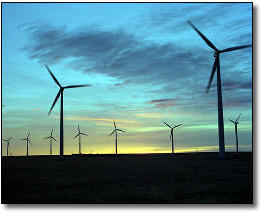
Image: NREL
 |
An expired tax
credit darkens the wind industry's 2004 outlook. Image: NREL |
"Our members tell us that 2004 could have been an even better year
than 2003 had the PTC extension in the energy bill gone into effect."
- AWEA Executive Director Randall Swisher
| Washington D.C. -
January 23, 2004 [SolarAccess.com] Nearly 1,700 MW of new wind
electric generating capacity - enough to serve approximately 425,000
average homes - were installed in the U.S. in 2003, the American Wind
Energy Association (AWEA) said in a recent statement. The near-record
performance for the American wind industry is overshadowed, however, by
the failure of Congress to pass comprehensive energy legislation
including a three-year extension of the wind energy production tax
credit (PTC), an incentive that is vital to the industry's future
growth. The credit expired December 31, 2003, leading to layoffs,
stalled projects, and a negative near-term market outlook. AWEA is urging Congress to act quickly to extend the PTC so the American public can reap the rewards of a growing base of fuel- and emission-free wind power. The trade group said 2003 was very close to the best year ever in the U.S. in terms of installed capacity, with 1,687 MW of new wind power constructed, topped only by the 1,696 MW installed in 2001. Current installed capacity in the U.S. is now over 6,370 MW, with utility-scale wind turbines installed in 30 states. The large buildup in capacity is a 36% increase over the installed wind power base in the U.S. at the beginning of the year. Over the last five years, U.S. wind capacity has expanded at an annual average rate of 28%, and preliminary indications are that 2003 continued the pattern of wind being t the fastest-growing electricity source in the world on a percentage basis. More wind power in the nation's power portfolio, AWEA said, means less reliance on fossil fuels, more economic development in rural areas, and more pollution-free electric power. With the PTC incentive, wind power is now in an increasingly competitive range with other generation sources, and the cost of wind-generated electricity is not affected by fuel price volatility. However, instead of building on the momentum established in 2003, the wind industry in 2004 is again waiting for a clear signal from Congress that will ensure the stable finance environment needed to promote the industry's continued development. "The record in 2001 and 2003 shows that the wind industry can ramp up quickly to meet the nation's power needs. However, like any new technology, wind power faces some market barriers. In order put this new technology to work for the American people, Congress should extend the wind energy production tax credit quickly," said AWEA Executive Director Randall Swisher. "Our members tell us that 2004 could have been an even better year than 2003 had the PTC extension in the energy bill gone into effect. There are thousands of megawatts of projects, representing billions of dollars in investments, that could move quickly if Congress takes action early in the year." - The wind farms completed in 2003, AWEA said, will generate approximately $5 million in payments to landowners annually and create some 200 skilled, long-term jobs in areas where such employment is scarce, as well as short-term construction jobs and associated economic activity. - The new wind capacity will displace emissions of three million tons of carbon dioxide (the leading greenhouse gas). - Oklahoma, Illinois, and Ohio got their first installations of large-scale wind turbines. Both Spanish turbine manufacturer Gamesa and Indian manufacturer Suzlon installed their first machines in the U.S., both in Minnesota. - Minnesota added the most new wind power (226 MW) of any state in 2003, moving back into third place in total capacity behind only California and Texas. Three other states topped the 200-MW mark in new installations in 2003: California, with 212 MW; New Mexico, with 205 MW; and Texas, with 204 MW. Leading states in cumulative capacity at year's end were California (2,043 MW), Texas (1,293 MW), Minnesota (563 MW), Iowa (472 MW), and Wyoming (285 MW). Minnesota-based construction firm Mortenson was involved in the construction of over 625 MW of the total added in the U.S. in 2003. - More than half of the new capacity installed in 2003 consisted of GE Wind turbines. In its first full year in the market after having purchased Enron Wind in early 2002, GE Wind has been a strong player in the U.S. market. The wind industry would only have to maintain an annual growth rate of about 18% to achieve AWEA's goal of providing six percent of the nation's electricity by the year 2020. The past year has shown that rate to be a readily achievable goal with strong and consistent policy support from federal and state governments. |
|
|
| For
Further Information: • AWEA Newsroom Please Note: SolarAccess.com and Arizonaenergy.org do not endorse the sites behind these links. We offer them for your additional research. Following these links will open a new browser window. |